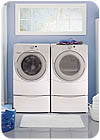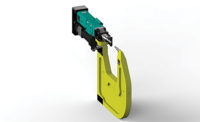
The Whirlpool Horizon is touted as one of the most efficient clothes dryers on the market. Coincidentally, the factory where the dryers are assembled is among the most efficient in the appliance industry.
The factory, Whirlpool Corp.'s assembly plant in Marion, OH, produces dryers on multiple assembly lines. Employing approximately 3,000 people in a three-shift, five-day-a-week operation, the plant assembles standalone dryers, as well as units for stacked washer-dryer pairs. Whirlpool's washers are assembled at the company's facility in Clyde, OH, located just north of Marion, and in the company's facility in Germany.
Besides the Whirlpool brand, the facility produces dryers under the brand names Kenmore, KitchenAid, Roper, Estate, Inglis, and now, Maytag, which the company purchased in April.
"The plant celebrated its 50th anniversary last year," boasts William G. Condon, materials engineer at the facility. "We have one of the largest paint systems in the world. We consume more sheet metal than a lot of automotive plants.
Over the past decade, the company has devoted significant resources to getting lean, increasing efficiency, improving safety and ergonomics, reducing pollution, and decreasing the amount of waste it sends to landfills. The paint line was overhauled to accommodate a more environmentally friendly process. Engineers worked with suppliers to design plastic returnable containers for many parts, such as lint screens, wire harnesses, timers and heating elements. Assembly lines were redesigned to accommodate just-in-time inventory, kanban and point-of-use parts supplies.
When the time came to design the assembly line for the Horizon, engineers saw an opportunity to take these efforts one step further. A 1,700-square-foot section of the plant was cleared out, and engineers started with a blank slate.
"Our other lines were designed from the supplier inwards. How are the parts coming in? Where will we store them? How will we position them on the line?" says Condon. "The Horizon line is the first line that we've designed from the operator out. What does the operator need?"
To improve ergonomics, engineers slowed the pace of the line from the time typical of other lines in the plant. Unlike the plant's other lines, which are elevated approximately 2 feet off the floor, the Horizon line operates close to floor level. Even the lighting was improved. "I don't know how many lumens it is, but it's the brightest spot in the plant," says Condon.
Dubbed "Saguaro" because of its multiarm configuration, the Horizon line is designed for mixed-model assembly. For example, a subassembly that was once produced in the plant's fabrication department is now done directly on the line. "Now, we don't have to carry a lot of inventory, and we're able to accommodate late-model differentiation," says Condon.
Compared with the plant's other assembly lines, fewer parts are stored on the Horizon line. "Instead of delivering a whole skid of 300 parts to an assembly station, we might bring in 50 parts at a time," he says.
Carts and Parts
Another key difference on the Horizon line is in how the parts are delivered to the assembly stations. Instead of using forklifts to deliver parts, the company opted for a system of carts pulled by electric tuggers.
There were several reasons for the switch. Because carts and tuggers are quicker and more nimble than forklifts, they are better able to meet the requirements for just-in-time parts delivery. Tuggers with carts need less space to maneuver than forklifts, and one tugger can deliver more parts on a single run than a forklift.
"A tugger can pull three or four carts of material, but a forklift can only deliver one skid at a time," says Condon.
Another reason was safety. "We've had some forklift accidents in the past, but we've never had any tugger accidents," says Condon.
Approximately half of the factory's fleet of 40 carts was supplied by Kinetic Technologies LLC (Willoughby Hills, OH), and the other half was supplied by Topper Industrial (Sturtevant, WI). The tuggers were built by Motrec Inc. (Bromptonville, Quebec).
In some cases, suppliers deliver parts in packaging designed specifically for use with the carts. In other cases, the parts are supplied on standard skids, which are then placed onto carts with a forklift at the loading dock.
The tugger driver delivers a cart near an assembly station, then pushes it into position by hand. Alternatively, the driver takes boxes of parts from the cart and loads them onto in-and-out flow racks custom-built with modular components from Creform Corp. (Greer, SC). Empty carts are towed back to the dock on the return trip.
The tuggers and carts deliver a variety of parts to the line, ranging from plastic racks to skids of electric motors weighing 1,500 pounds. For some parts, Topper built carts that work in conjunction with hydraulic lifts mounted to the floor. Once the cart is positioned over the lift, operators can raise or lower the container to the ideal working level on the line. Operators can also tilt the cart by as much as 30 degrees, enabling them to reach parts in the back of the container with less effort.
Kinetic Technologies designed a cart specifically to accommodate large metal stampings. The stampings are stacked on plywood. The base of the cart can rotate 360 degrees, so when operators run out of stampings on one side of the board, they can turn the board 180 degrees to reach the stampings on the other side. Kinetic designed another cart with two levels, so one cart can carry two different parts in one run.
"We have all these parts with different geometries and containers, yet, from an assembly standpoint, the operators always have optimal parts presentation," says Condon.
Despite a few initial hiccups, the forklift-free strategy has been a success. "There's been a little more labor for material handling, but that's been offset by the ergonomic benefits," he says.
If the new parts delivery strategy is a long-term success on the Horizon line, engineers hope to make the entire assembly plant a forklift-free operation, says Condon.
For more information on material handling carts, call Kinetic Technologies at 216-431-6353, visit www.k-tec.bz, or eInquiry 30. Engineers can also call Topper Industrial at 262-886-6931, visit www.topperindustrial.com, or eInquiry 31.
For more information on electric tuggers, call Motrec at 866-846-3558, visit www.motrec.com, or eInquiry 32.
For more information on modular components for building workstations and material handling systems, call Creform at 800-839-8823, visit www.creform.com, or eInquiry 33.
100 Million Appliances and Counting...
Whirlpool's Marion plant reached a milestone earlier this year. The facility assembled its 100 millionth appliance, a Duet clothes dryer, on March 30.
"This is a major milestone for the people of this division," says Stan Kinnett, vice president of Whirlpool's Marion Division. "Very few appliance manufacturers will ever earn the right to make this claim in one manufacturing facility."
Kinnett gave credit for the accomplishment to the plant's employees. "Records like this are achieved by people who come to work every day and put their hearts into their jobs, ensuring that uninterrupted production continues day after day, year after year. We have a very dedicated group of people."
As part of the celebration, all employees received a T-shirt commemorating the occasion, and one employee won the 100,000,001st unit, also a Duet dryer.
Whirlpool began assembling appliances in Marion in 1955. During the past 51 years, the facility has produced commercial dry cleaners, built-in and free-standing ranges, room air conditioners, microwave ovens and clothes dryers. Today, however, only dryers are assembled at the plant.

